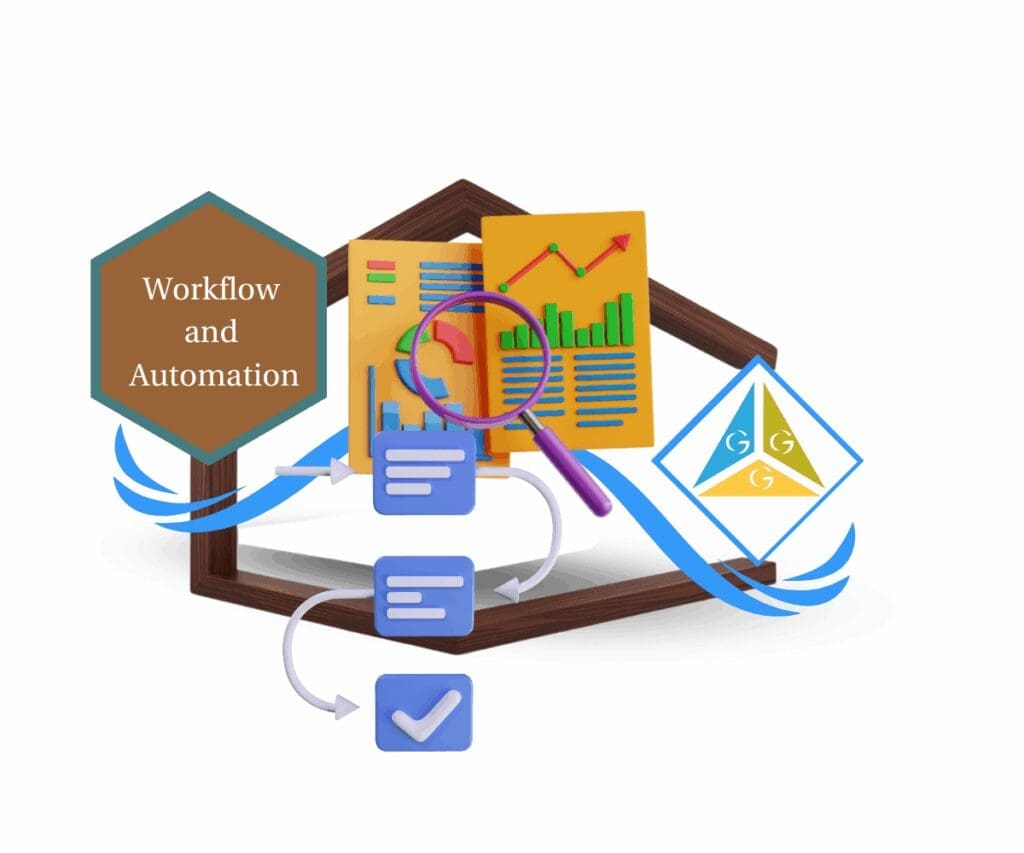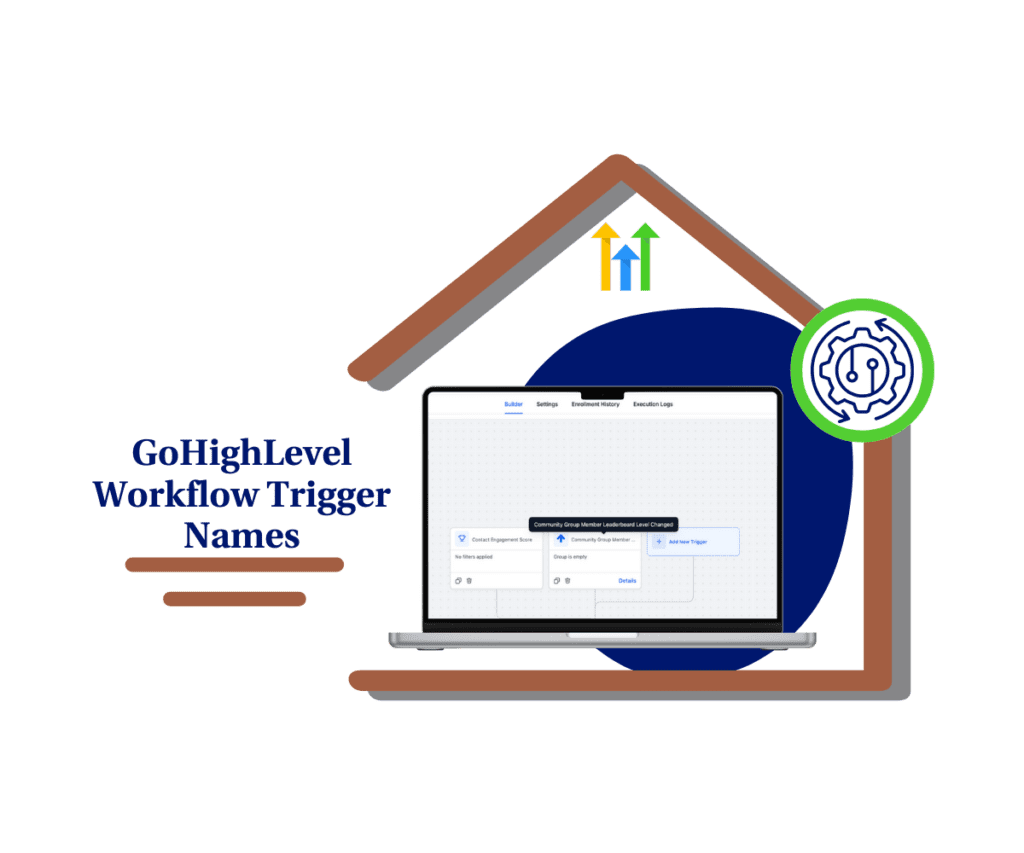- Keep your sales pipeline alive with the Stale Opportunities workflow trigger
- Quick Summary – Stale Opportunities Essentials
- What’s New: The Stale Opportunities Trigger
- Why Stale Opportunities Matter in Sales Pipelines
- How to Use the Stale Opportunities Trigger How to Use the Stale Opportunities Trigger
- Pro Tips for Maximizing the Stale Opportunities Trigger
- Real-World Use Cases of the Stale Opportunities Trigger
- Results You Can Expect from Automating Stale Opportunities
- FAQs About the Stale Opportunities Trigger
- Conclusion – Automating Stale Opportunities for a Healthier Pipeline
Keep your sales pipeline alive with the Stale Opportunities workflow trigger
Stale opportunities are every salesperson’s silent killer. A deal sits too long in one stage, untouched, and suddenly it’s gone cold. GoHighLevel’s stale opportunities workflow trigger changes that by giving you a built-in safety net. With this automation, no deal goes forgotten, and no sales rep gets caught sleeping on a lead.
This trigger automatically identifies opportunities that have been sitting idle for too long and kicks off an action—like sending a reminder, alerting a manager, or even reassigning the deal. It’s like putting a watchdog inside your pipeline. By using the stale opportunities trigger, you’ll keep your pipeline moving, prevent leads from slipping through the cracks, and save time with automation.
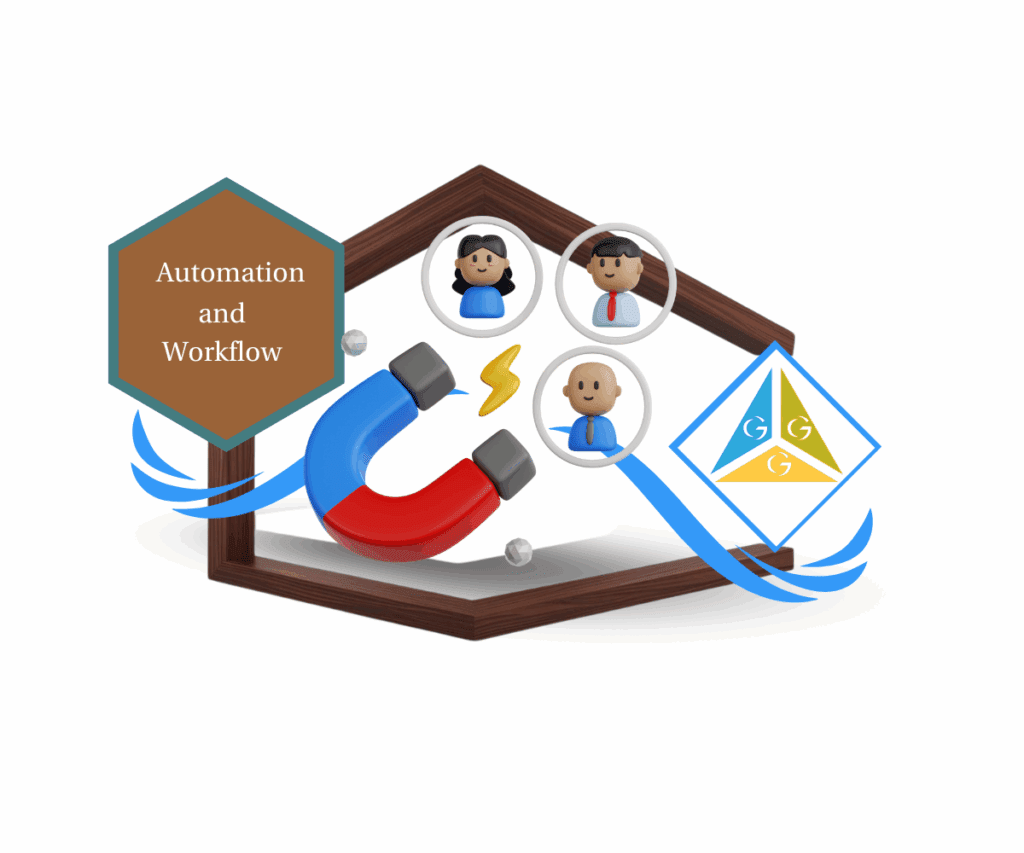
By using the stale opportunities trigger, you’ll keep your pipeline moving, prevent leads from slipping through the cracks, and save time with automation.
Quick Summary – Stale Opportunities Essentials
The stale opportunities trigger helps you stop losing deals by automatically flagging inactive opportunities and kicking off smart follow-ups. It matters because it keeps your pipeline clean, your team accountable, and your close rates higher. You get automated reminders, manager alerts, and deal reassignments without the manual work. Setting it up takes just a few minutes in GoHighLevel workflows. The difficulty level is low, but the payoff is huge—more re-engaged prospects, fewer forgotten leads, and a sales pipeline that actually reflects reality.
Purpose: The stale opportunities trigger automatically flags idle deals and takes action so your pipeline stays active.
Why It Matters: Stalled deals drag down forecasts and waste potential. This trigger ensures no opportunity slips away unnoticed.
What You Get: Automated reminders, internal notifications, manager alerts, and the option to reassign or move deals for review.
Time to Complete: Setup takes only a few minutes inside GoHighLevel workflows.
Difficulty Level: Beginner-friendly. No advanced setup required.
Key Outcome: A cleaner, more accurate sales pipeline with higher engagement and stronger close rates.
What’s New: The Stale Opportunities Trigger
The stale opportunities workflow trigger is designed to wake up your pipeline when deals stall. Instead of manually checking every stage and chasing down sales reps, this trigger automatically detects when an opportunity has been sitting idle for too long.
Here’s how it works: if an opportunity remains in the same stage without updates for a set number of days, the trigger activates. From there, you decide what happens next—send a follow-up email, ping the rep with an internal notification, or move the deal into a review stage.
Automate marketing, manage leads, and grow faster with GoHighLevel.
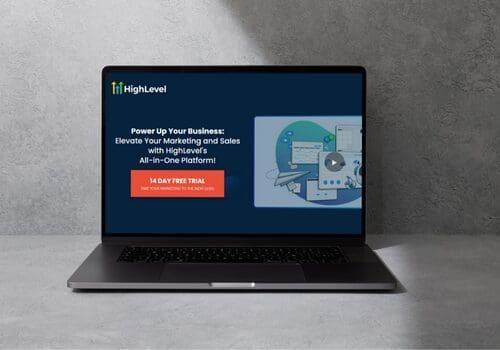
For example, if a prospect has been stuck in “Negotiation” for five days without any movement, the trigger can fire off an email to the rep reminding them to follow up, while also notifying the sales manager that action is needed.
This automation ensures no potential lead slips through the cracks. Instead of stale opportunities clogging your pipeline, you get a system that calls attention to them and sparks action at exactly the right time.
Why Stale Opportunities Matter in Sales Pipelines
A sales pipeline is only as strong as the activity inside it. When opportunities stall, they don’t just waste space—they quietly drain momentum, skew forecasts, and frustrate both sales reps and managers. That’s where the stale opportunities trigger proves its value.
First, it gives you proactive pipeline management. Instead of waiting until deals are dead, the trigger helps reps re-engage before it’s too late. Second, it improves response times. A quick nudge—whether by email or an internal alert—reminds your team to take action faster.
For managers, it provides better visibility. When an opportunity has gone stale, leaders can step in, offer support, or even reassign the deal to someone who can move it forward. That means fewer missed chances and stronger accountability.
Finally, it reduces manual work. No more spreadsheets, sticky notes, or guesswork. The system itself tracks inactivity and enforces follow-ups, leaving your sales team free to focus on conversations that actually close deals.
With this trigger in place, your pipeline stays active, accurate, and productive—exactly what a growth-focused agency or sales team needs.
How to Use the Stale Opportunities Trigger How to Use the Stale Opportunities Trigger
Setting up the stale opportunities trigger in GoHighLevel is straightforward, but it pays to do it right. Once configured, it will quietly monitor your pipeline and fire off actions whenever deals sit idle for too long. Here’s the step-by-step process:
Step 1.0 – Access the Main Left Hand Menu in GoHighLevel
- The Main Menu on the Left side of your screen has all the main areas that you work in when using GHL
1.1 Click on the Automation Menu Item.
- Access the ‘Automation’ section of GoHighLevel
- You’ll now be in the ‘Automation’ section of GHL, where you can access the Funnels section from the top menu:
1.2 Click on the ‘Create New Workflow’ menu link.
- Click create “new workflow” and in the drop down menu “start from scratch”
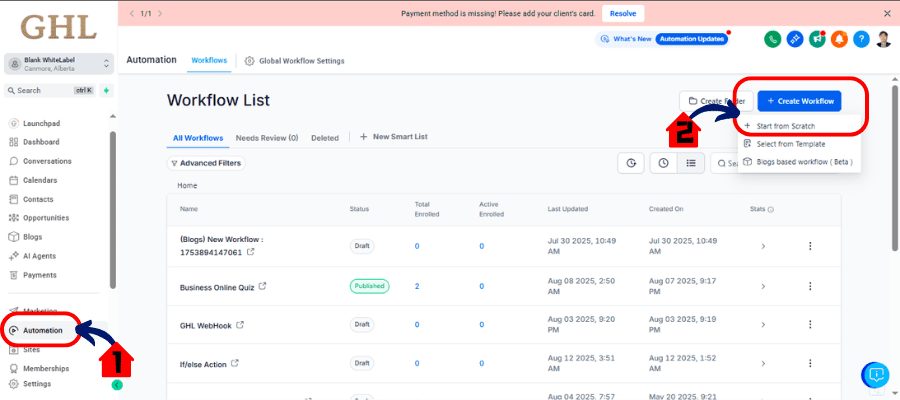
Step 02 – Add the Stale Opportunities Trigger
2.1 Add Trigger
- Inside the workflow, click + Add New Trigger.
2.2 Select Stale Opportunities from the trigger list.
- Give it a name you’ll recognize later, such as “Stale Deal Follow-Up.”
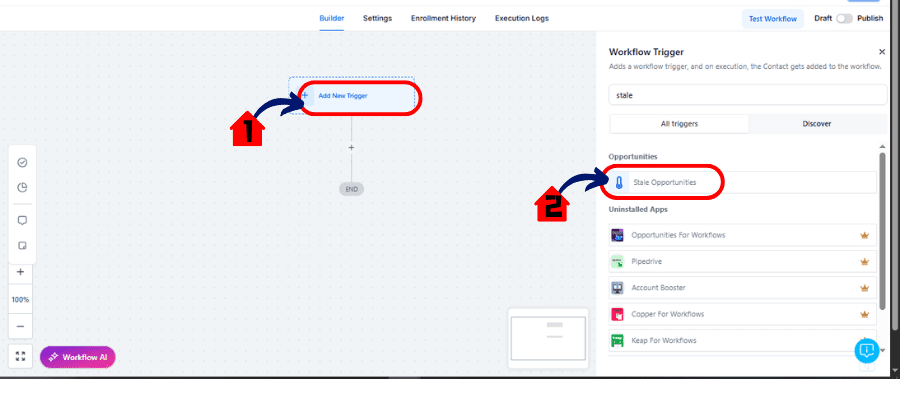
Step 03 – Configure Trigger Filters
3.1 Click Add Filters
- Set Duration in Days (e.g., 3 days).
- Select the Pipeline where this rule applies (e.g., Sales Pipeline).
- Choose the specific Pipeline Stage (e.g., Negotiation).
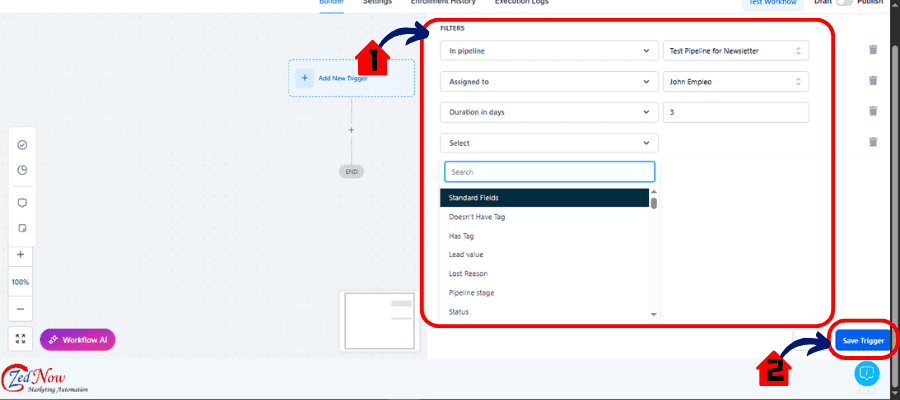
- To learn More you can try any other filters to get your Stale Leads turn to hot Leads.
3.2 Save Trigger
Step 04 – Add Workflow Actions
4.1 Add Action
- Add an action such as Send Reminder Email to the assigned rep.
- Add a second action like Notify Manager for visibility.
- Optionally, move the deal into a Review stage for follow-up.
4.2 Publish Workflow
- Once satisfied, toggle Publish to turn it live.
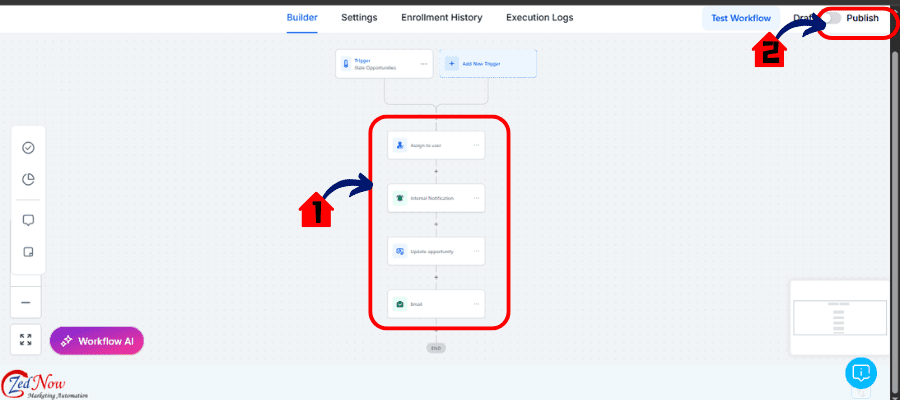
After this setup, your system will automatically catch and react to stale opportunities, making sure nothing falls through the cracks.
Pro Tips for Maximizing the Stale Opportunities Trigger
The stale opportunities trigger is powerful on its own, but a few smart tweaks can take it from good to game-changing.
First, customize by sales cycle length. Shorter cycles (like quick service sales) may only need a 2–3 day inactivity window, while longer B2B cycles might require 7–10 days before flagging a deal as stale. Matching duration to cycle length keeps alerts meaningful.
Second, use filters to avoid false alarms. Not every quiet opportunity is truly neglected. Add conditions to exclude deals with recent activities such as emails, notes, or calls. This prevents unnecessary pings to your team.
Third, don’t stop at just reminders. Build escalation steps for high-value opportunities. For example, if a $50K deal goes stale, notify the sales manager immediately, not just the rep.
Finally, combine it with Smart Lists. By automatically shifting stale deals into a “Review Required” stage, you create an easy list of deals needing attention. This adds structure to pipeline hygiene and ensures nothing slips away unnoticed.
With these pro tips, the stale opportunities trigger becomes more than a safety net—it turns into a disciplined system that keeps your pipeline clean, efficient, and focused on the deals most likely to close.
Real-World Use Cases of the Stale Opportunities Trigger
The best part of the stale opportunities trigger is how flexible it is. Agencies and sales teams can tailor it to their own style of pipeline management. Here are a few examples of how it works in action:
Re-engaging stalled deals
When an opportunity sits in “Negotiation” for more than five days, the system automatically sends a follow-up email to the prospect. This small nudge often revives conversations that would otherwise fade away.
Holding sales reps accountable
Instead of letting deals slip by unnoticed, the trigger reminds sales reps directly when one of their opportunities goes cold. It keeps them on their toes and ensures prospects don’t get forgotten.
Manager visibility on high-value deals
For bigger-ticket opportunities, managers get notified when the deal hasn’t moved in the pipeline. That extra oversight helps leadership step in, provide guidance, or reassign as needed.
Pipeline hygiene
Some agencies move stale opportunities into a “Review Required” stage. This helps the team quickly filter which deals are worth saving and which ones should be closed out, keeping the pipeline lean and realistic.
These use cases show how the stale opportunities trigger doesn’t just automate reminders—it creates a culture of consistency, follow-through, and proactive pipeline management.
Results You Can Expect from Automating Stale Opportunities
Once the stale opportunities trigger is in place, you’ll notice the difference almost immediately. Deals stop falling through the cracks, and your pipeline starts to reflect reality instead of a cluttered list of forgotten leads.
One of the biggest results is improved close rates. By catching deals before they die, your reps get more chances to re-engage prospects and move them forward. Even a few extra conversions each month can add up to big revenue gains.
You’ll also see stronger pipeline hygiene. With stale deals automatically flagged or moved to review, managers can focus on what’s truly active. Forecasting becomes more accurate, and team meetings stop being about chasing ghosts.
Another key result is increased accountability. Sales reps get regular nudges to stay on top of their deals, while managers gain visibility into who’s taking action and who’s dropping the ball. This creates a healthier sales culture built on responsiveness and ownership.
Finally, you save time. Instead of manually scanning pipelines and sending follow-ups, the automation does the heavy lifting. Your team spends less energy on admin work and more energy on closing.
In short, the stale opportunities trigger doesn’t just clean up your pipeline—it keeps your entire sales process sharper, faster, and more effective.
FAQs About the Stale Opportunities Trigger
Conclusion – Automating Stale Opportunities for a Healthier Pipeline
Stale opportunities are a fact of sales life—but they don’t have to be the death of your pipeline. With GoHighLevel’s stale opportunities trigger, you can take control of idle deals before they disappear.
This automation helps sales reps stay on track, gives managers real-time visibility, and ensures that follow-ups happen when they matter most. It also keeps your pipeline clean, accurate, and focused on active deals, which means better forecasting and stronger close rates.
If you’re serious about keeping your sales engine running smoothly, this trigger is a must-have. Don’t let deals die quietly—put automation in place to revive them and keep your pipeline alive.
Have you tried setting up stale opportunities in your workflow yet? Share your experience and let us know how it’s working for your team.
Scale Your Business Today.
Streamline your workflow with GoHighLevel’s powerful tools.


